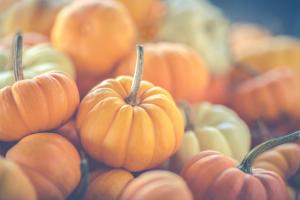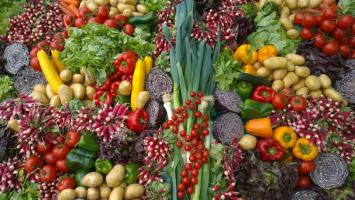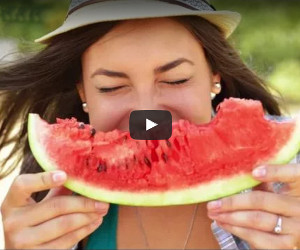
DIET & LIFESTYLE
DISCOVER HOW TO HEAL
How Much Fried Food Can you Handle?French fries & funnel cakes are a fun way to enjoy the local fair. Eat too much though, and you start to feel queasy. This is a sign you've hit your upper limit on fried foods. Uggh! The hot sun continues to beat down on you as the food churns in your stomach. So, how much fried food can you digest? How much is too much? The answer has to do with your bile.Bile & Digestion of FatBile kick starts the digestion of fat. It is made in the liver and then makes its way into the gallbladder where it is concentrated and stored. Understanding how bile works in the body and assessing your bile production can help you make an informed decision about funnel cakes and fries, and support better fat metabolism.When your french fries reach the small intestine, stored bile is released and mixed with the fries to break up large fat globs into small droplets for easy digestion (a process called emulsification). Fatty, fried food demands alot of bile production from the liver. If you overdo your fry intake, there might not be enough bile to emulsify the fat and you could end up with a nausea and/or diarrhea. These symptoms don't exactly scream pass the ketchup... Bile & Development of GallstonesGot sludge? When your gallbladder is sluggish, or there is too much cholesterol in your bile, bile tends to thicken into a substance called biliary sludge. Formation of sludge precedes stone formation. Once sludge or stones start to form, the bile may be stuck in the gall bladder.A tell tale sign of sludge or stones is waking up with spasmodic pain in the middle of the night after indulging in a fatty meal. Congested bile may make you nauseous and even vomit. If you experience pain in the right and central upper abdomen (the area where your liver and gallbladder are) there could be bile congestion. Pain may also be referred to the right shoulder blade area. These symptoms are also symptoms of gallstones. When this happens, take the safe route and go to the hospital to get your gallbladder checked (usually by sonogram). The cool, heavy and stable qualities of Kapha can lead to sludge formation. Kapha people tend to have thicker bile that gets congested in the gall bladder, which leads to bile sludge, gallstones and gallbladder attack. Too much fried, fatty foods increases the viscosity of bile fluids and likelihood of stone formation. Often there will be other signs of thick fluids as well, such as thick saliva or mucus. The skin may be thick, pale and cool to the touch. Individuals with congested bile may be constipated by the lack of bile flow. When bile is congested you may end up with side effects like headaches, nausea, indigestion, constipation after you eat a meal high in fat. Congested bile also causes poor fat digestion and metabolism. Bile - Excess & DeficiencyIf you produce too much bile, it will irritate your intestines, give you diarrhea, and also overstimulate your mind. The dosha most closely associated with increased output of bile is Pitta. Pitta people are therefore more prone to bile excess. Your body also tends to produce more bile in hot summer months. So, reducing bile production is key to less irritability when the weather is hot.Vata tends to be deficient in bile due to dryness. This leads to constipation. Vata bile is thin. Whether congested, too much, or too little, healthy bile production is essential to healthy digestion of fried foods, and health in general. What is Bile Like? What are its Effects?Bile (also called gall / bile acids / bile salts) is a green/yellow alkaline fluid produced by the liver and stored in the gallbladder. If you felt it, it would be oily and slimy to the touch. Ayurvedically, bile is hot, sharp and oily. The tastes associated with bile are bitter, sour, pungent and salty. As mentioned it is related to Pitta dosha and the elements of fire and water.Bile is responsible for giving poop a cinnamon brown color. When bile output is low, the stool color fades, turning a cardboard color. If bile output is very low, your stool may be oily, shiny and float because it's full of undigested fat. Bile salts and bilirubin are the main active ingredients in bile. Bilirubin itself is a byproduct of the breakdown and recycling of red blood cells. Otherwise, bile is composed of 97% water, 0.7% bile salts, 0.2% bilirubin, 0.51% fats (cholesterol, fatty acids and lecithin) and 200 meq/l inorganic salts. Bile is important for the absorption of fat soluble nutrients like vitamins A, D, K and E. However, as a surfactant and detergent, bile salts and acids are toxic to cells. Bilirubin is a fiery substance that aids the inflammatory process, thins the blood, and contributes to the breakup of mucus. When the liver is under stress, these components of bile are released into the bloodstream, irritating the body (a condition called choleric heat in Greek medicine). This is why liver stress leads to increased Pitta. Bilirubin is the substance that makes your skin and the corners of your eyes yellow, which are cardinal signs of high Pitta. Bile also irritates the intestines. This is why too much bile in the intestines leads to the Pitta condition of soft stools and diarrhea, while too little leads to constipation. One of the liver's main functions is detoxification of the blood. In both phases of liver detoxification, the liver excretes the "conjugated" toxins through the bile, including carcinogens, xenobiotic chemicals, pharmaceuticals, heavy metals like mercury, aluminum and lead. Flushing this toxic bile directly reduces Pitta dosha and refreshes the liver. Bile is recycled and reused 4-6 times daily. Bile release is stimulated hormonally by the release of cholecystokinin in the duodenum.
Bile & CholesterolBile also happens to be an important pathway for cholesterol metabolism which is good because fatty, fried foods increase cholesterol. Stimulating bile flow can help lower cholesterol, which is how some herb formulas like Bitter Ghee work to help those with cholesterol problems. Stimulating bile flow also flushes your gall bladder, preventing it from getting clogged up with stones. In a country where 1/2 million people lose their gallbladders annually and 1/3 of the population has high cholesterol - these facts make bile a hot topic.What Do You Do About Congested, Thick Bile Sludge?To liquefy and flush bile, use cholagogues. Cholagogues are a class of herbs and foods that increase bile production and release into the small intestine. Cholagogues help to flush the liver and gall bladder of congested bile. Raw beets are a cholagogue, for example, serving to thin the bile and encourage its healthy flow. Foods with bitter taste are especially helpful in flushing the gallbladder - so chow down on arugula and dandelion greens. Green juices often have cholagogue properties. Herbs like neem, kutki, guduchi, bhumyamalaki and dandelion (root and leaves) all are all bitter cholagogues. Aloe vera gel or juice is an ideal cholagogue. Sour taste, such as found in lemons and limes, is also a cholagogue.Reduce dietary consumption of oils. A little bit of healthy fats like ghee and coconut oil are necessary to stimulate the release of bile, but chips, fries, donuts and the like should be off the menu. Steer clear of red meat, refined flours and sugars as these thicken fluids and make circulation sluggish. Instead, eat a high fiber and high protein diet with lots of vegetables, legumes and nuts. Avoid foods like pizza and sandwiches that make you feel tired after eating them. Opt for soups and salads instead. Favor the Kapha pacifying tastes of pungent, bitter and astringent. Some useful pungent herb formulas include guggulu and shilajit. Grapefruits are bitter and sour, so they make a great choice for increasing bile flow. Vegetable juicing - especially with bitter green veggies - can also bring Kapha back into balance. Drink hot water to help move stagnation. What Do You Do About Deficient Bile?Signs and symptoms of deficient bile include sluggish digestion, constipation, fatty stools, heartburn, pale tongue, pale urine, cold and pale skin, fatigue, difficulty digesting fat, bloating and hormone imbalance. A blood test can be used to confirm whether your bile is low.Deficient bile usually relates to Vata being out of balance by its rough, dry or cold qualities. The liver may be exhausted or damaged (rough quality). The liver is dried out due to dehydration (dryness). Or, the liver may be cold due to poor metabolism or anemia. Drink plenty of water as bile is primarily composed of it. If you're dehydrated, your bile production will suffer. You'll also want to stock up on good fats like ghee, coconut and olive oil to stimulate the production of bile. Apple sauce is both sweet and sour, nourishing and stimulating the liver - a win win here. Salt will help increase digestive secretions and calm Vata. Vata should use digestives like ginger, black pepper, garlic and onion to warm things up. What Do You Do About Excess Bile?Take note of any yellow discoloration in the skin or eyes as this indicates an excess of bile. Anger and intense emotions are another cue that you're fired up with extra bile. Diarrhea can be caused by excess bile.To reduce bile output, avoid alcohol, spicy food, and vasodilators which can increased blood flow through the liver. Keep your body cool, avoid the hot mid-day sun and anything that makes you sweat. Astringent taste will reduce bile secretion. To reduce yellowing of the eyes, be gentle with your liver by following the above suggestions, and avoiding caffeine and fatty foods. Coconut water, blueberries, and other cooling, pitta pacifying foods may be helpful. What Causes Excess Bile?In the intestines of a healthy individual, less than .5g of bile acid remains after re-absorption. When excessive amounts of bile remain, they enter the colon. There, the bile stimulates water secretion and increased peristalsis, causing chronic diarrhea. A cardinal sign of excessive bile in the intestines is chronic soft stool or diarrhea that is not due to parasites, food allergies, or other causes.The presence of too much bile in the intestines is caused by several factors:
OverproductionHot weather causes the heart rate to increase and blood vessels to dilate, which both exhausts the liver and leads to increased production of bile. Hemolytic anemias such as sickle cell anemia and thalassemia can lead to excessive production of bile. This is why individuals with these conditions tend to be Pitta dominant.Gall Bladder RemovalGallbladder removal may result in continual bile release into the small intestine, irritating it. Bile reflux can irritate the stomach and esophagus.Poor absorptionRe-absorption of bile is affected by damage to the brush border membrane of the small intestine. This may be due to food allergies, parasites, Crohn's, or other conditions.In pancreatic insufficiency, the duodenum is too acidic, causing bile salts to precipitate out of solution, making them ineffective for fat digestion and non absorbable by the ileum. Instead, they are eliminated through the feces. Bile is absorbed in the ileum. Surgical removal of the ileum (usually due to Crohn's) results in excessive bile release into the colon. Parasites that cause diarrhea may cause bile to be eliminated before it can be absorbed. Imbalance in gut bacteria may also affect bile digestion, leading to poor absorption. Excess elimination of bile eventually depletes the bile acid pool. Assessment of BileBile Production
Bilirubin in the bloodExcessive bile production as well as liver problems can cause his levels of bilirubin in the blood. Increased bilirubin levels could be caused by diseases of the liver such as hepatitis or blood disorders like hemolytic anemia.Too much bile in the blood looks like high Pitta. Signs and symptoms include irritability, anger, overly critical, and a yellow discoloration to the skin and eyes. New research indicates that bile may play a role in glucose metabolism. Components of bile acid have been shown to lower glucose levels and improve glycemic regulation in people with type 2 diabetes. - https://www.ncbi.nlm.nih.gov/pmc/articles/PMC2821506/
Your bile production affects more than you might think. Keep healthy by keeping tabs on how it's flowing. READ MORE ON THIS TOPIC
BROWSE SIMILAR ARTICLES BY TOPICCHOLAGOGUECholagogues stimulate the production & release of bile from the liver & gallbladder. This refreshes and cleanses these organs, as well as increases bile in the small intestines.

About the Author John Immel, the founder of Joyful Belly, teaches people how to have a healthy diet and lifestyle with Ayurveda biocharacteristics. His approach to Ayurveda is clinical, yet exudes an ease which many find enjoyable and insightful. John also directs Joyful Belly's School of Ayurveda, offering professional clinical training in Ayurveda for over 15 years.John's interest in Ayurveda and specialization in digestive tract pathology was inspired by a complex digestive disorder acquired from years of international travel, as well as public service work in South Asia. John's commitment to the detailed study of digestive disorders reflects his zeal to get down to the roots of the problem. His hope and belief in the capacity of each & every client to improve their quality of life is nothing short of a personal passion. John's creativity in the kitchen and delight in cooking for others comes from his family oriented upbringing. In addition to his certification in Ayurveda, John holds a bachelor's degree in mathematics from Harvard University. John enjoys sharing Ayurveda within the context of his Catholic roots, and finds Ayurveda gives him an opportunity to participate in the healing mission of the Church. Jesus expressed God's love by feeding and healing the sick. That kindness is the fundamental ministry of Ayurveda as well. Outside of work, John enjoys spending time with his wife and 7 kids, and pursuing his love of theology, philosophy, and language. STUDY AYURVEDA
Questions, Comments & Impressions of 'how to increase fat metabolism: ayurvedic tips for healthy bile'?Is there something else you'd like to know about 'how to increase fat metabolism: ayurvedic tips for healthy bile'?65 likes      Sign in to review this article Sign in to review this article
|
Join Joyful Belly.
Want our top Ayurvedic recipes and health tips?Subscribe to our free newsletter!

 SAVE ARTICLE
SAVE ARTICLE

 On MeWe
On MeWe On Pinterest
On Pinterest On Facebook
On Facebook On Twitter
On Twitter On WhatsApp
On WhatsApp On Email
On Email


